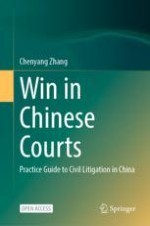Open Access 2023 | Open Access | Book

Win in Chinese Courts
Practice Guide to Civil Litigation in China
Author: Chenyang Zhang
Publisher: Springer Nature Singapore
Open Access 2023 | Open Access | Book

Author: Chenyang Zhang
Publisher: Springer Nature Singapore
This open access book aims to provide an initial but comprehensive roadmap for the Chinese civil litigation system. It starts with some basic concepts of the Chinese judicial system (e.g., court system, case numbering, hierarchical trial system, etc.) and runs through the entire process and most aspects of civil litigation cases (e.g., jurisdiction, service of process, rules of evidence, enforcement, representative actions, etc.).
The first target audience for this book is lawyers outside of mainland China. For professors and law students, this book also serves as a window into the Chinese judicial system in a short period of time. It is my hope that this book serves as a backdrop for additional observations of Chinese judicial practice, such as a review of recent cases.
This is an open access book.